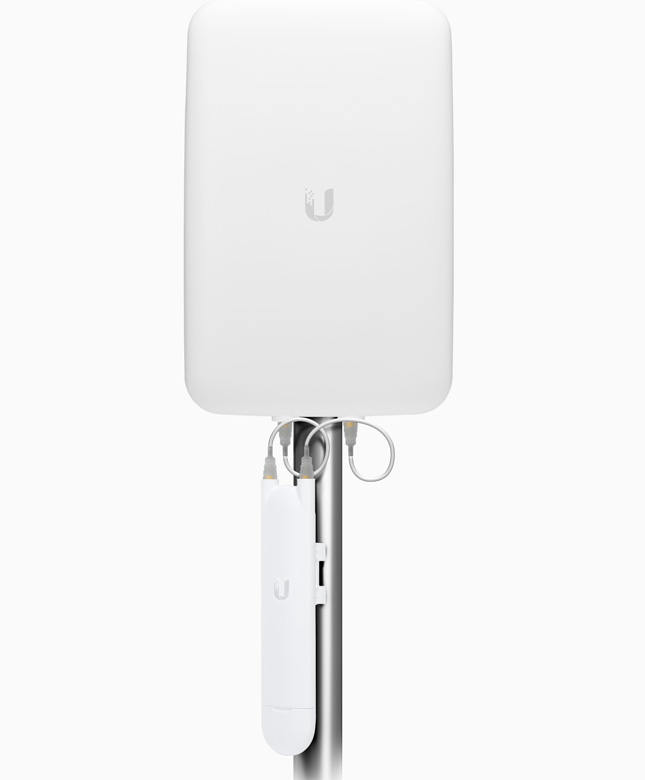
What is Mesh and what is it used for?
Essentially, Mesh is a grid of access points that are all aware of each other and connected together. They are intelligent which means that if one goes down, the other access points automatically re-connect and continue to talk to each other meaning that they can still route traffic.
Mesh is really useful for situations where you have to cover a large area but there is only one physical internet connection. The access points cover the area wirelessly creating a mesh network that keeps the entire area covered.
It is worth noting that if it is possible to use a wired connection through an ethernet cable, then that would be the better option as it will have a superior performance over a wireless mesh uplink.
How to arrange Ubiquiti Constituent Parts
If you’re wondering what the interrelated Ubiquiti parts are and how they fit together, then read on. Remember that you will always need a router to do the routing in your network – UniFi Mesh access points are not routers.
You’ll see below that we’ve listed all Ubiquiti equipment. This isn’t essential, you don’t need to use Ubiquiti equipment for all devices, but if you do it offers the highest compatibility and scalability.
- Access points: UniFi Meshor UniFi Mesh PRO
- Router: UniFi Security Gatewayor UniFi Security Gateway PRO. The PRO version, as hinted in the name, has more functions and is more powerful. E.g. multiple LAN and WAN ports as well as SFP (Small Form-factor Pluggable) ports for fibre modules.
- Switch(optional if needed): 8-Port UniFi Gigabit Switch
- UniFi Controller: To be able to configure all of the above UniFi devices, you will need to download UniFi Controller onto a computer or tablet. This is a free software solution that will enable you to configure and manage all of the UniFi devices in your network. If you would like to observe and log all of the network statistics then the computer will need to be running all the time. If this feels a little daunting, then Ubiquiti sells a UniFi Cloud Keyfor this exact purpose. It is a small computer with a UniFi Controller installed on it which can be connected and running all of the time.
A real world example
Imagine you are hosting an outdoor event, like a festival themed wedding. You want guests to be able to #hashtag your wedding moment by moment, but you’ve picked an outside venue with little mobile reception. You have one wired connection available, and the rest need to be wireless across the entire area to provide seamless coverage.
The devices you could use are:
- 1x UniFi Security Gateway PRO (multiple LAN and WAN ports)
- 4x UniFi Mesh PRO (access points to match the gateway; MAIN, 1, 2 and 3)
- UniFi Cloud Key (to enable configuration and provide network statistics)
The location where you are able to set up a wired connection would be your MAIN location, where you could connect a UniFi Security Gateway with one physically connected UniFi Mesh Pro access point. The remaining 3 access points would be connected wirelessly to the main Mesh Pro device.
Remember! Mesh devices all work on a 5GHz and 2.4GHz frequency. UniFi Mesh technology works exclusively on 5GHz for wireless uplink, so it’s best to keep this frequency solely for this purpose, and then use 2.4GHz for clients devices (e.g. phones, tablets, laptops etc). If you do it this way, the 5GHz uplinks won’t get overloaded by client devices.
With this set up you should be able to achieve good overall performance, with roaming between access points working seamlessly. Wedding hashtag saved!
You will see that on the devices that they say the coverage is anything up to 180m. It’s a good idea to err on the side of caution with this, and not stretch it to it’s limit. This will help make sure you don’t encounter potential range issues.
With devices that use small antenna like smartphones and tablets, you have to remember that they’re not as powerful. They can receive signal well, but can struggle when transmitting back to the access point. To try and avoid any performance issues because of this, don’t push the coverage range and keep the distance between Mesh devices around 100 metres.
Remember! We mentioned about channels above. You need to also make sure that you’re not getting overlaps on your 2.4GHz channel. If you stop this from happening, you can reduce if not eliminate any access point interference.
Here is an example of what channels you could use to avoid any interference issues:
- Mesh device 1 – Channel 1
- Mesh device 2 – Channel 11
- Mesh device 3: Channel 1
We hope you found this blog helpful.
For more information on how Ubiquiti UniFi devices could help your network – Whether it be business, home or event – Please don’t hesitate to get in touch. Our Wi-Fi experts work out of Hampshire, London and Cardiff and are ready to help with your Wi-Fi woes.
Contact us here.
With thanks to https://www.ui.com/unifi/unifi-mesh-antenna/ for the image.
